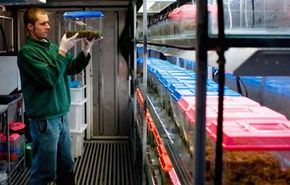Chytrid Fungus and Disappearing Frogs
Today, a major threat to frogs is the chytrid fungus. This fungus feeds on keratin, a component of skin that makes it sturdy and tough. Tadpoles have only a little keratin around their mouths. But as frogs grow, their skin thickens on the soles of their feet and anywhere else their bodies repeatedly come in contact with the ground, such as the lower abdomen. So while the fungus doesn't usually affect tadpoles, it can kill adult frogs. Researchers aren't yet sure of exactly how the fungus kills the frogs. The two prevailing theories are that the fungus produces lethal toxins or that its presence interferes with the exchange of oxygen and carbon dioxide through the skin.
At present, scientists believe that this fungus came from African clawed frogs. These frogs carry the fungus on their skin but suffer no ill effects from it. However, African clawed frogs have spread far beyond their native habitat, carrying the fungus with them, due to global trade. Scientists around the world have used these frogs for research and, from the 1930s to the 50s, to conduct pregnancy tests. People have also kept the frogs as pets. The fungus isn't just riding on the backs of one species of frog today, though. Researchers suspect that it may now be spreading through airborne spores.
Advertisement
Researchers believe that about a third of the frogs in the world may face extinction due to the chytrid fungus. Some species have already disappeared. There is no effective treatment for the fungus, so researchers around the world are trying to quarantine as many frog species as possible. One such quarantine facility is the $500 million Amphibian Ark project.
Although the chytrid fungus is a global problem, there are a couple of things you can do to help stop its spread. First, report the appearance of sick frogs or frogs that seem to have died without an obvious cause to your local authorities. Second, never, ever release pet frogs into the wild. Released pet frogs can breed, overwhelming the local frog population, and they can spread disease. Again, contact your local authorities to inquire about what to do.
You can learn more about frogs, amphibians and related topics by browsing the links below.
Related HowStuffWorks Articles
More Great Links
- American Museum of Natural History: Frogs, A Chorus of Colors
- University of Wisconsin Sea Grant: Frogs
- Animal Diversity Web: Frog Calls
- Exploratorium: Frogs
- The Whole Frog Project
Sources
- Abrams, Michael. "Leap Forward, High Over It." Discover. 1/1/1996 (2/1/2008). http://discovermagazine.com/1996/jan/leapforwardhigho646/?searchterm=frogs
- American Museum of Natural History. "Goliath Frog." (2/1/2008) http://www.amnh.org/nationalcenter/Endangered/frog/frog.html
- Beltz, Ellin. "Frogs: Inside Their Remarkable World." Firefly. 2005.
- Graham, Sarah. "Common Weed Killer Disrupts Frogs' Sexual Development." Scientific American. 4/16/2002 (2/1/2008) http://www.sciam.com/article.cfm?id=common-weed-killer-disrup
- Graham, Sarah. "Researchers Pinpoint Source of Poison Frogs' Deadly Defenses." Scientific American. 8/9/2005 (2/1/2008) http://www.sciam.com/article.cfm?articleID=000A2086-B7D6-12F7-B7D683414B7F0000&ref=sciam
- Grenard, Steve. "Frogs and Toads." Howell Book House. 2008.
- Holmes, Bob. "Reptiles Join Amphibians in Mysterious Decline." New Scientist. 4/16/2007 (2/1/2008) http://environment.newscientist.com/channel/earth/dn12432-killer-fungus-goes-airborne.html
- Khamsi, Roxanne. "Friction Helps Frogs Stick to Ceilings." 4/12/2007 (2/1/2008). http://environment.newscientist.com/channel/earth/dn12432-killer-fungus-goes-airborne.html
- Ma, Lybi. "The Year in Science: Animals 1997, A Plague on Frogs." Discover. 1/1/1998 (2/1/2008). http://discovermagazine.com/1998/jan/theyearinscience1396/?searchterm=frogs
- Morell, Virginia. "The Fragile World of Frogs." National Geographic. May 2001.
- New Scientist. "Frogs' Legs Are Their Undoing." 9/24/2006 (2/1/2008) http://environment.newscientist.com/channel/earth/dn12432-killer-fungus-goes-airborne.html
- New Scientist. "Non-stick Protein Spawns New Antibiotics." 8/25/2007 (2/1/2008). http://technology.newscientist.com/channel/tech/mg19526183.200-nonstick-frog-protein-spawns-new-antibiotics.html
- Roach, John. "Frog-inspired Tape Reusable, Doesn't Lose Grip." National Geographic News. 10/11/2007 (2/1/2008) http://news.nationalgeographic.com/news/2007/10/071011-frog-adhesive.html
- San Diego Zoo. "Defenses: Frog and Toad." (2/1/2008) http://www.sandiegozoo.org/animalbytes/t-frog_toad.html
- Smithsonian National Zoological Park. "Poison Dart Frogs." (2/1/2008) http://nationalzoo.si.edu/Animals/Amazonia/Facts/fact-poisondartfrog.cfm
- Smithsonian National Zoological Park. "Reptiles and Amphibians." (2/1/2008)http://nationalzoo.si.edu/Animals/ReptilesAmphibians/Index/default.cfm
- Tesler, Pearl et al. "Frogs." Exploratorium. (2/1/2008) http://www.exploratorium.edu/frogs/
- Tyler, Michael et al. "How Frogs and Humans Interact: Influences Beyond Habitat Destruction, Epidemics and Global Warming." Applied Herpetology. Vol. 4 2007.
- Young, Emma. "Killer Fungus Goes Airborne." New Scientist. 8/6/2007 (2/1/2008). http://environment.newscientist.com/channel/earth/dn12432-killer-fungus-goes-airborne.html.
